check engine TOYOTA PRIUS C 2012 NHP10 / 1.G Owner's Manual
[x] Cancel search | Manufacturer: TOYOTA, Model Year: 2012, Model line: PRIUS C, Model: TOYOTA PRIUS C 2012 NHP10 / 1.GPages: 552, PDF Size: 8.27 MB
Page 365 of 552
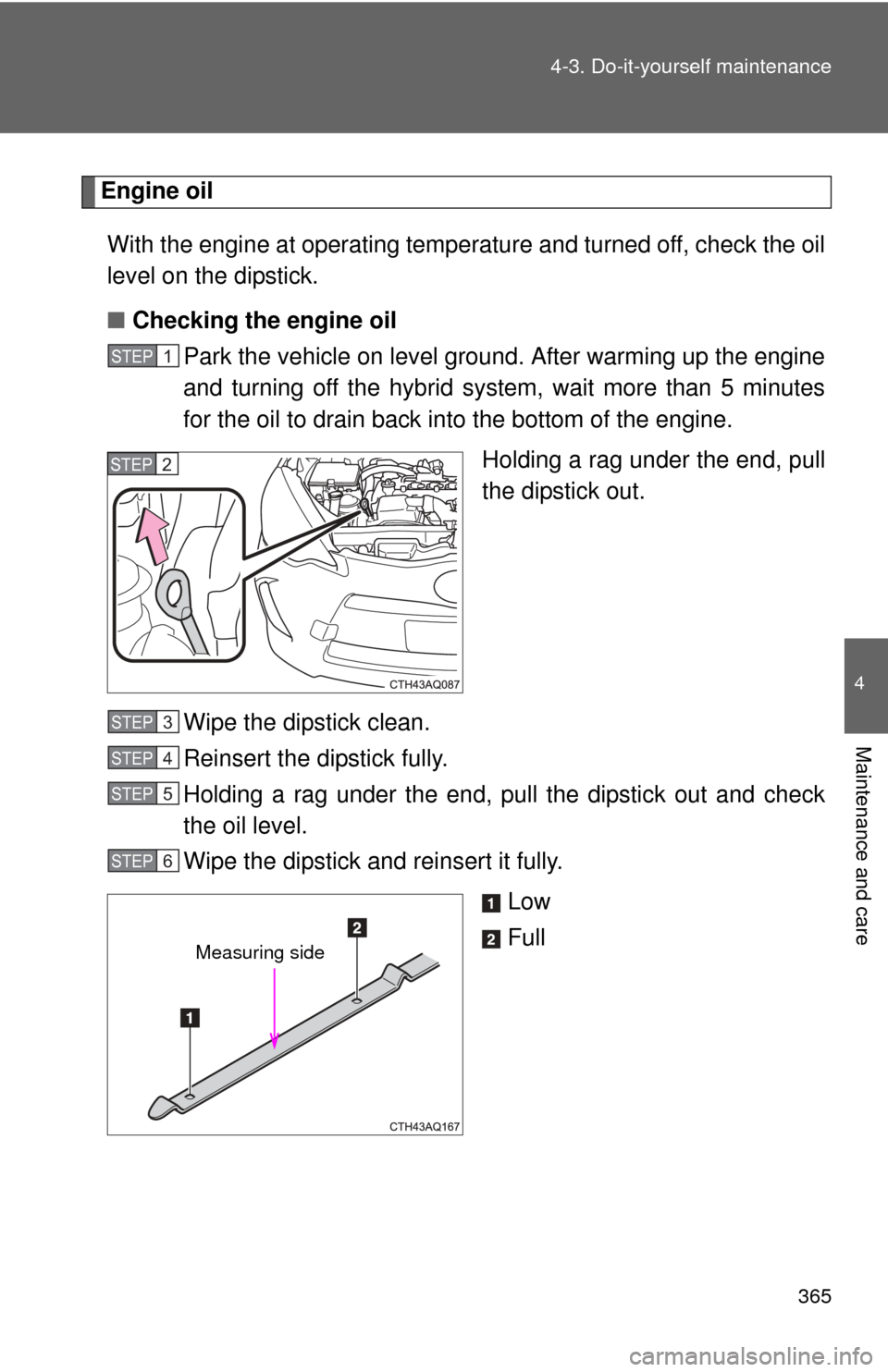
365
4-3. Do-it-yourself maintenance
4
Maintenance and care
Engine oil
With the engine at operating temperature and turned off, check the oil
level on the dipstick.
■ Checking the engine oil
Park the vehicle on level ground. After warming up the engine
and turning off the hybrid system, wait more than 5 minutes
for the oil to drain back in to the bottom of the engine.
Holding a rag under the end, pull
the dipstick out.
Wipe the dipstick clean.
Reinsert the dipstick fully.
Holding a rag under the end, pull the dipstick out and check
the oil level.
Wipe the dipstick and reinsert it fully. Low
Full
STEP1
STEP2
STEP3
STEP4
STEP5
STEP6
Measuring side
Page 366 of 552
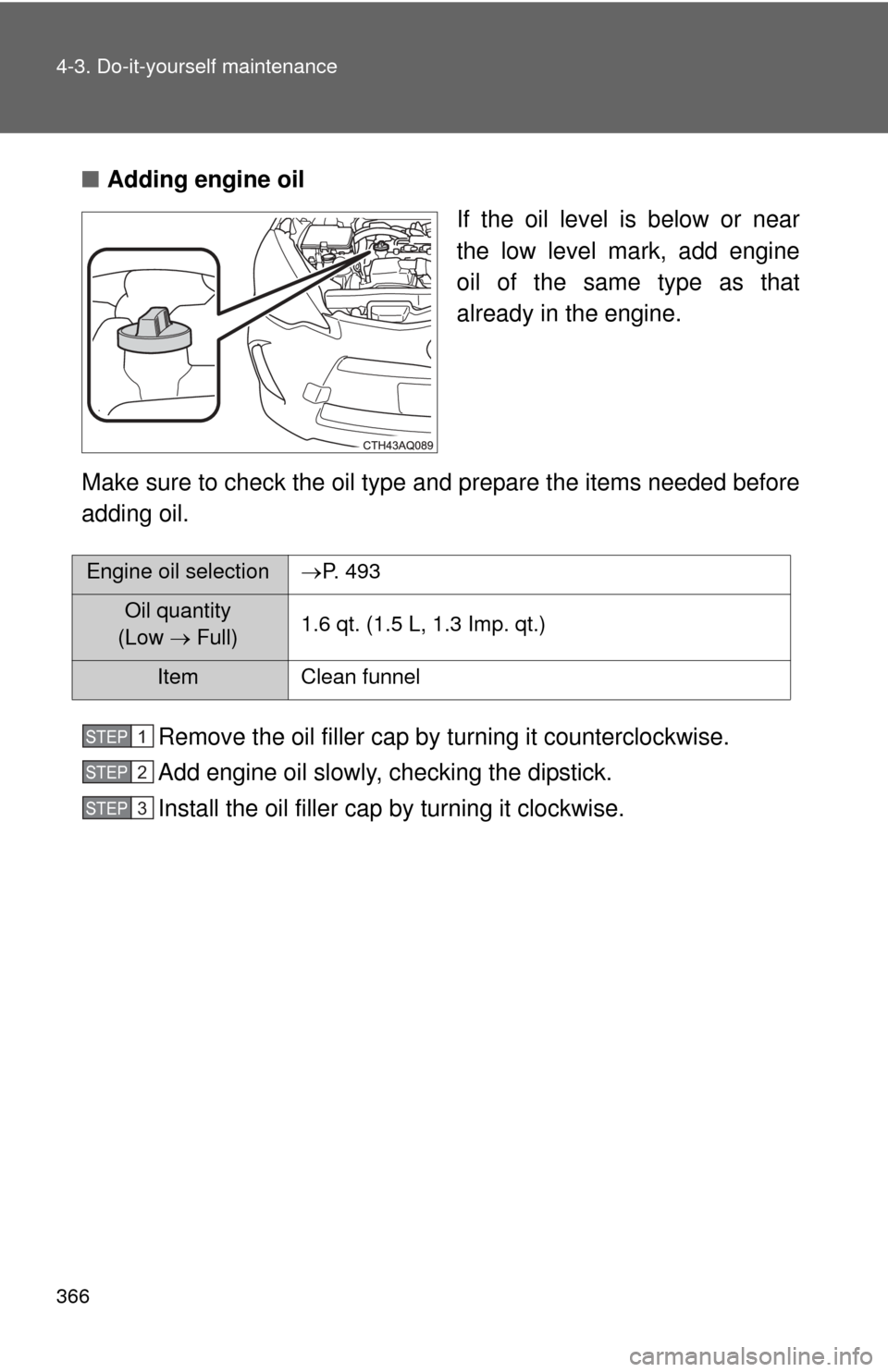
366 4-3. Do-it-yourself maintenance
■Adding engine oil
If the oil level is below or near
the low level mark, add engine
oil of the same type as that
already in the engine.
Make sure to check the oil type and prepare the items needed before
adding oil.
Remove the oil filler cap by turning it counterclockwise.
Add engine oil slowly, checking the dipstick.
Install the oil filler cap by turning it clockwise.
Engine oil selection P. 493
Oil quantity
(Low Full) 1.6 qt. (1.5 L, 1.3 Imp. qt.)
Item Clean funnel
STEP1
STEP2
STEP3
Page 368 of 552

368 4-3. Do-it-yourself maintenance
NOTICE
■To prevent serious engine damage
Check the oil level on a regular basis.
■ When replacing the engine oil
●Be careful not to spill engine oil on the vehicle components.
● Avoid overfilling, or the engine could be damaged.
● Check the oil level on the dipstick every time you refill the vehicle.
● Be sure the engine oil filler cap is properly tightened.
Page 370 of 552
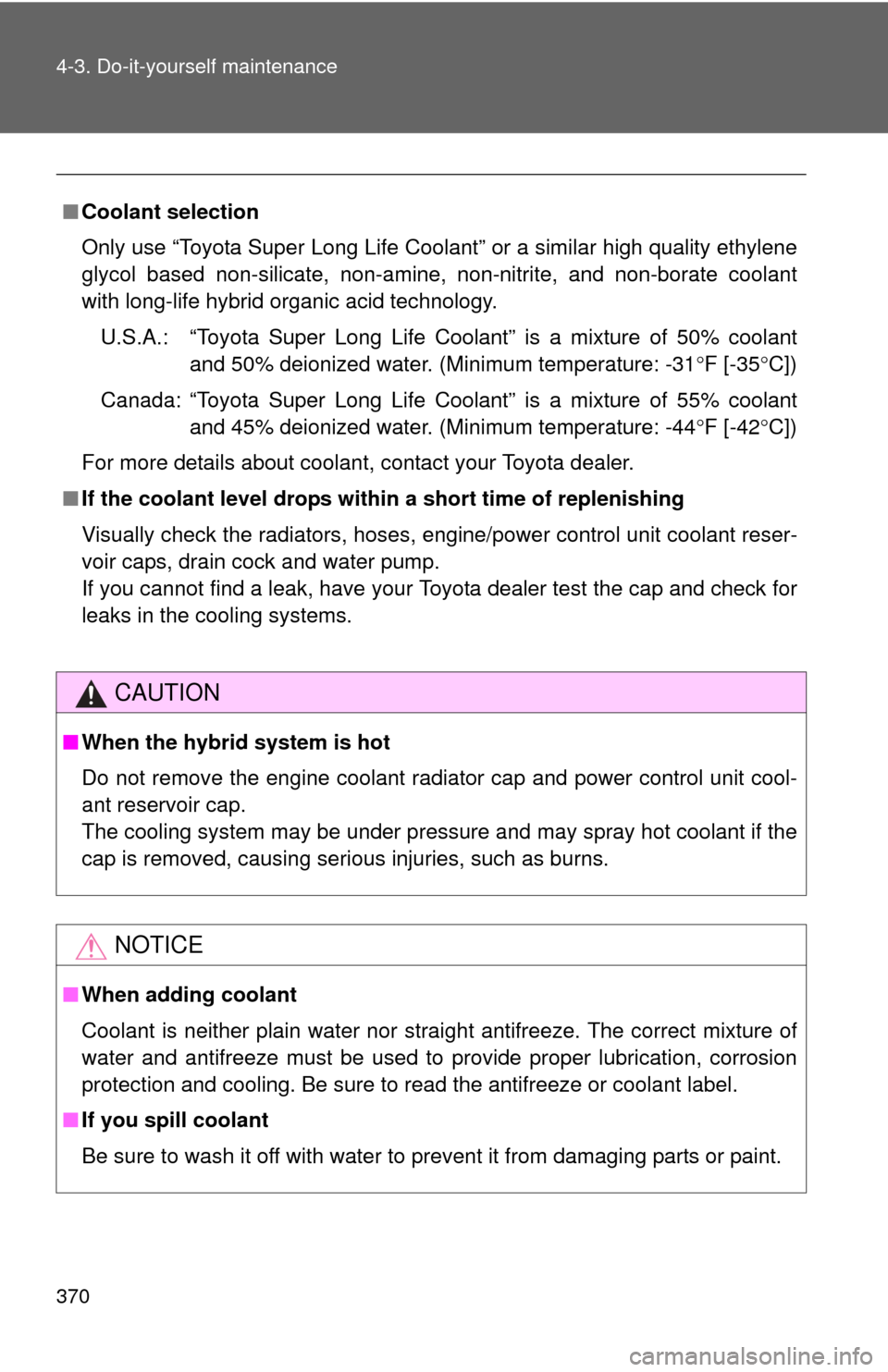
370 4-3. Do-it-yourself maintenance
■Coolant selection
Only use “Toyota Super Long Life Coolant” or a similar high quality ethylene
glycol based non-silicate, non-amine, non-nitrite, and non-borate coolant
with long-life hybrid organic acid technology.
U.S.A.: “Toyota Super Long Life Coolant” is a mixture of 50% coolant and 50% deionized water. (Minimum temperature: -31 F [-35 C])
Canada: “Toyota Super Long Life Coolant” is a mixture of 55% coolant and 45% deionized water. (Minimum temperature: -44 F [-42 C])
For more details about coolant, contact your Toyota dealer.
■ If the coolant level drops within a short time of replenishing
Visually check the radiators, hoses, engine/power control unit coolant reser-
voir caps, drain cock and water pump.
If you cannot find a leak, have your Toyota dealer test the cap and check for
leaks in the cooling systems.
CAUTION
■When the hybrid system is hot
Do not remove the engine coolant radiator cap and power control unit cool-
ant reservoir cap.
The cooling system may be under pressure and may spray hot coolant if the
cap is removed, causing serious injuries, such as burns.
NOTICE
■When adding coolant
Coolant is neither plain water nor stra ight antifreeze. The correct mixture of
water and antifreeze must be used to provide proper lubrication, corrosion
protection and cooling. Be sure to read the antifreeze or coolant label.
■ If you spill coolant
Be sure to wash it off with water to prevent it from damaging parts or paint.
Page 400 of 552
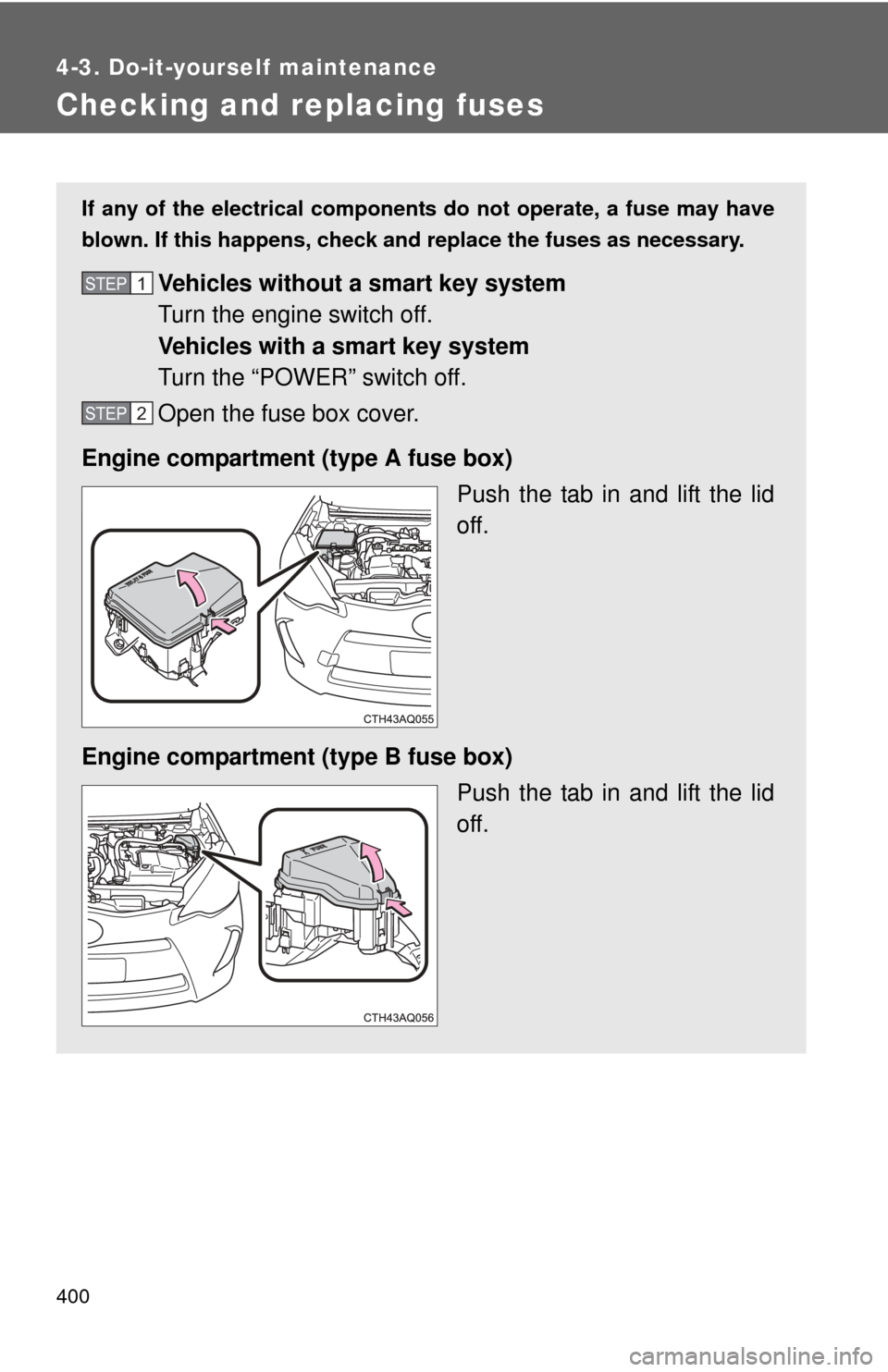
400
4-3. Do-it-yourself maintenance
Checking and replacing fuses
If any of the electrical components do not operate, a fuse may have
blown. If this happens, check and replace the fuses as necessary.
Vehicles without a smart key system
Turn the engine switch off.
Vehicles with a smart key system
Turn the “POWER” switch off.
Open the fuse box cover.
Engine compartment (type A fuse box) Push the tab in and lift the lid
off.
Engine compartment (type B fuse box) Push the tab in and lift the lid
off.STEP1
STEP2
Page 437 of 552

5
When trouble arises
437
5-2. Steps to take in an emergency
■If the tire pressure warning system is not functioning
The tire pressure warning system will be disabled in the following condi-
tions:
(When the condition be
comes normal, the system will work properly.)
●If tires not equipped with tire pressure warning valves and transmit-
ters are used
●If the ID code on the tire pressure warning valves and transmitters is
not registered in the tire pressure warning computer
●If the tire inflation pressure is 73 psi (500 kPa, 5.1 kgf/cm2 or bar) or
higher
The tire pressure warning system may be disabled in the following condi-
tions:
(When the condition be comes normal, the system will work properly.)
●If electronic devices or facilities using similar radio wave frequencies
are nearby
●If a radio set at a similar frequency is in use in the vehicle
●If a window tint that affects the radio wave signals is installed
●If there is a lot of snow or ice on the vehicle, particularly around the
wheels or wheel housings
●If non-genuine Toyota wheels are used (Even if you use Toyota
wheels, the tire pressure warning system may not work properly with
some types of tires.)
●If tire chains are used
■If the tire pressure warning light frequently comes on after blinking
for 1 minute
If the tire pressure warning light frequently comes on after blinking for 1
minute when the engine switch is tu rned to the “ON” position (vehicles
without a smart key system) or the “POWER” switch is turned to ON
mode (vehicles with a smart key syst em), have it checked by your
Toyota dealer.
■ Customization that can be co nfigured at Toyota dealer
The vehicle speed linked seat belt reminder buzzer can be disabled. (Cus-
tomizable features P. 516) However, Toyota recommends that the seat
belt reminder buzzer be operational to alert the driver and front passenger
when seat belts are not fastened.
Page 480 of 552
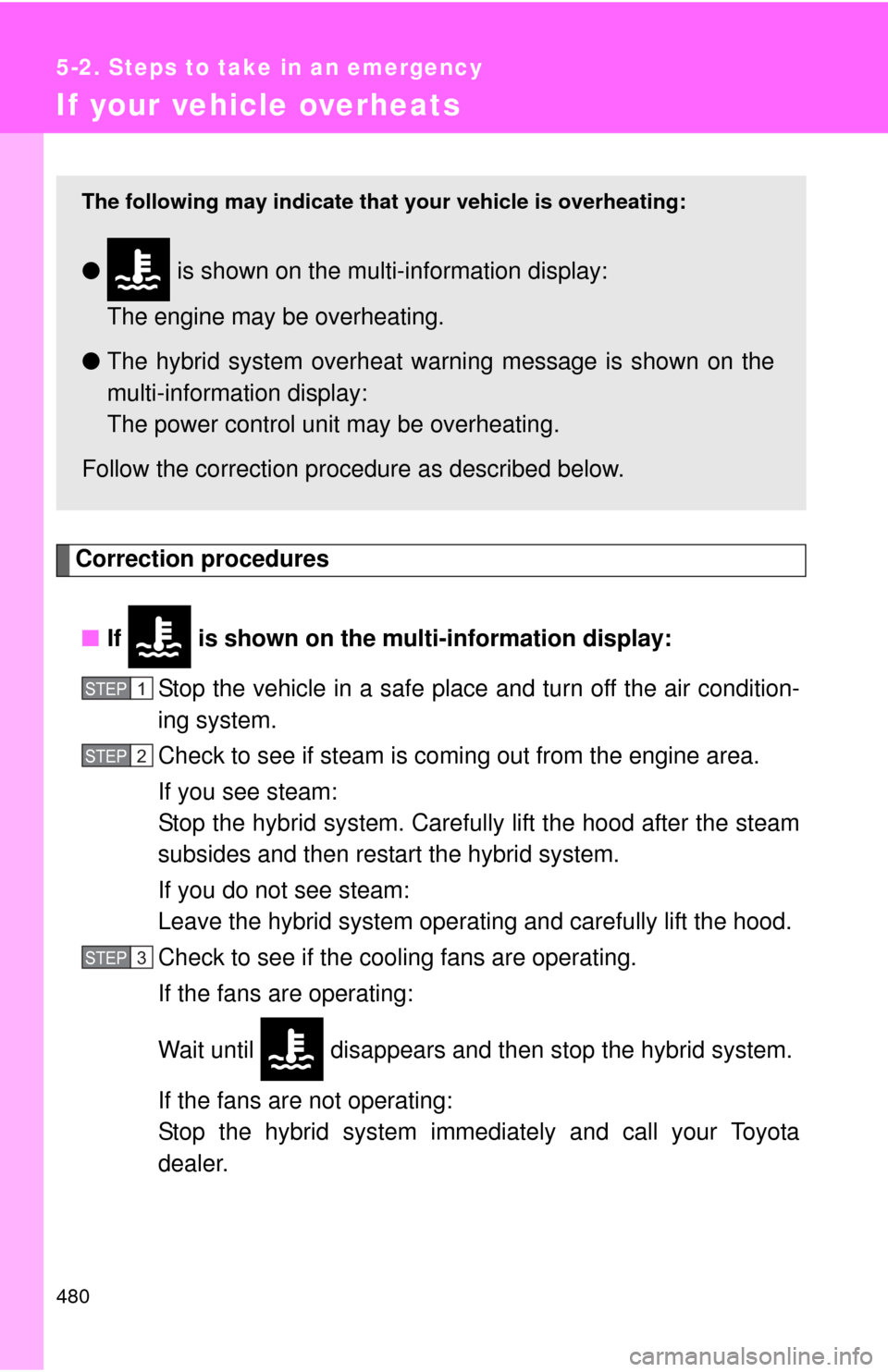
480
5-2. Steps to take in an emergency
If your vehicle overheats
Correction procedures■ If is shown on the mu lti-information display:
Stop the vehicle in a safe place and turn off the air condition-
ing system.
Check to see if steam is coming out from the engine area.
If you see steam:
Stop the hybrid system. Carefully lift the hood after the steam
subsides and then restart the hybrid system.
If you do not see steam:
Leave the hybrid system operating and carefully lift the hood.
Check to see if the cooling fans are operating.
If the fans are operating:
Wait until disappears and then stop the hybrid system.
If the fans are not operating:
Stop the hybrid system immediately and call your Toyota
dealer.
The following may indicate that your vehicle is overheating:
● is shown on the multi-information display:
The engine may be overheating.
● The hybrid system overheat wa rning message is shown on the
multi-informat ion display:
The power control unit may be overheating.
Follow the correction procedure as described below.
STEP1
STEP2
STEP3
Page 481 of 552
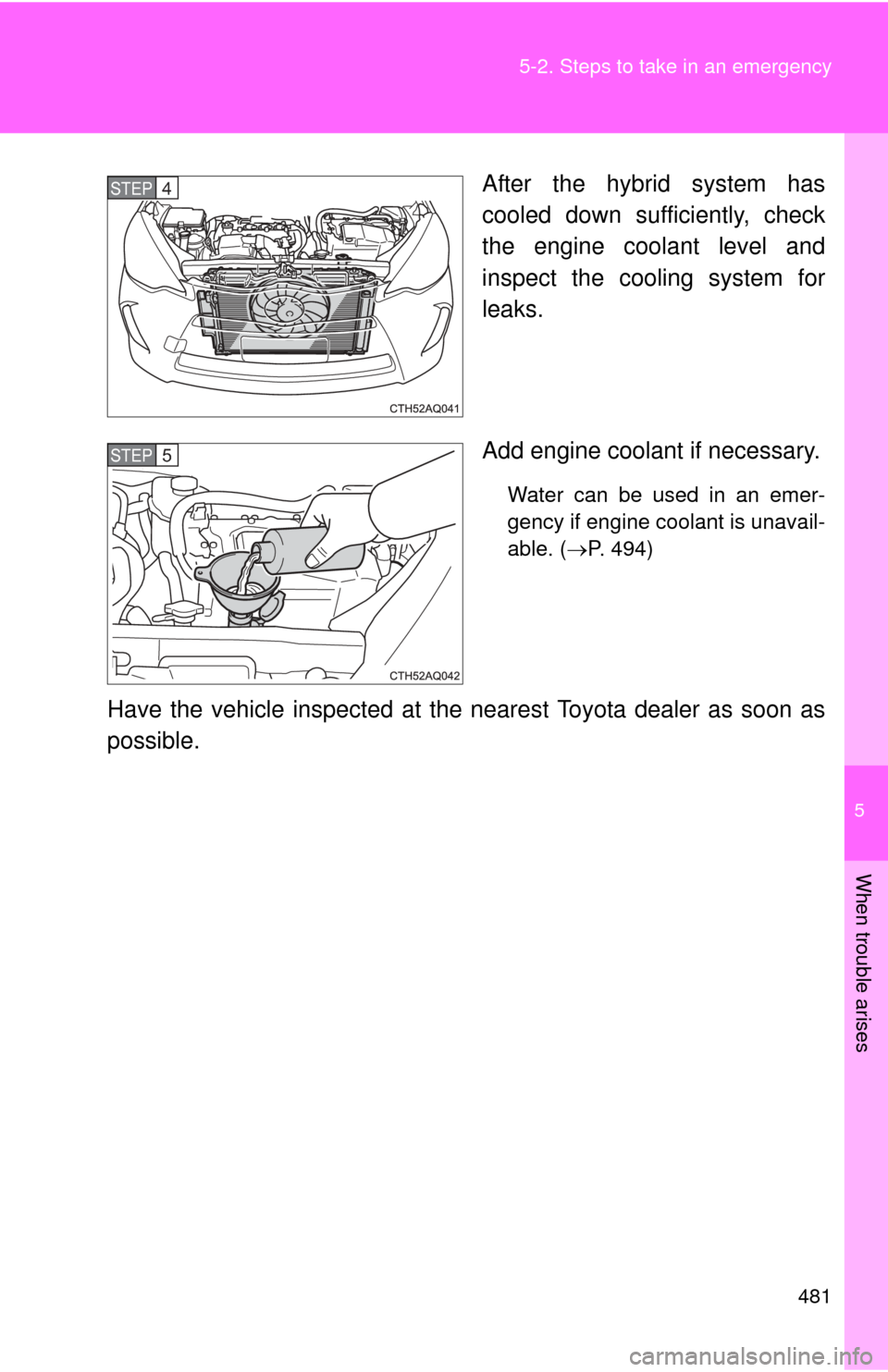
5
When trouble arises
481
5-2. Steps to take in an emergency
After the hybrid system has
cooled down sufficiently, check
the engine coolant level and
inspect the cooling system for
leaks.
Add engine coolant if necessary.
Water can be used in an emer-
gency if engine coolant is unavail-
able. (
P. 494)
Have the vehicle inspected at the nearest Toyota dealer as soon as
possible.
STEP4
STEP5
Page 483 of 552
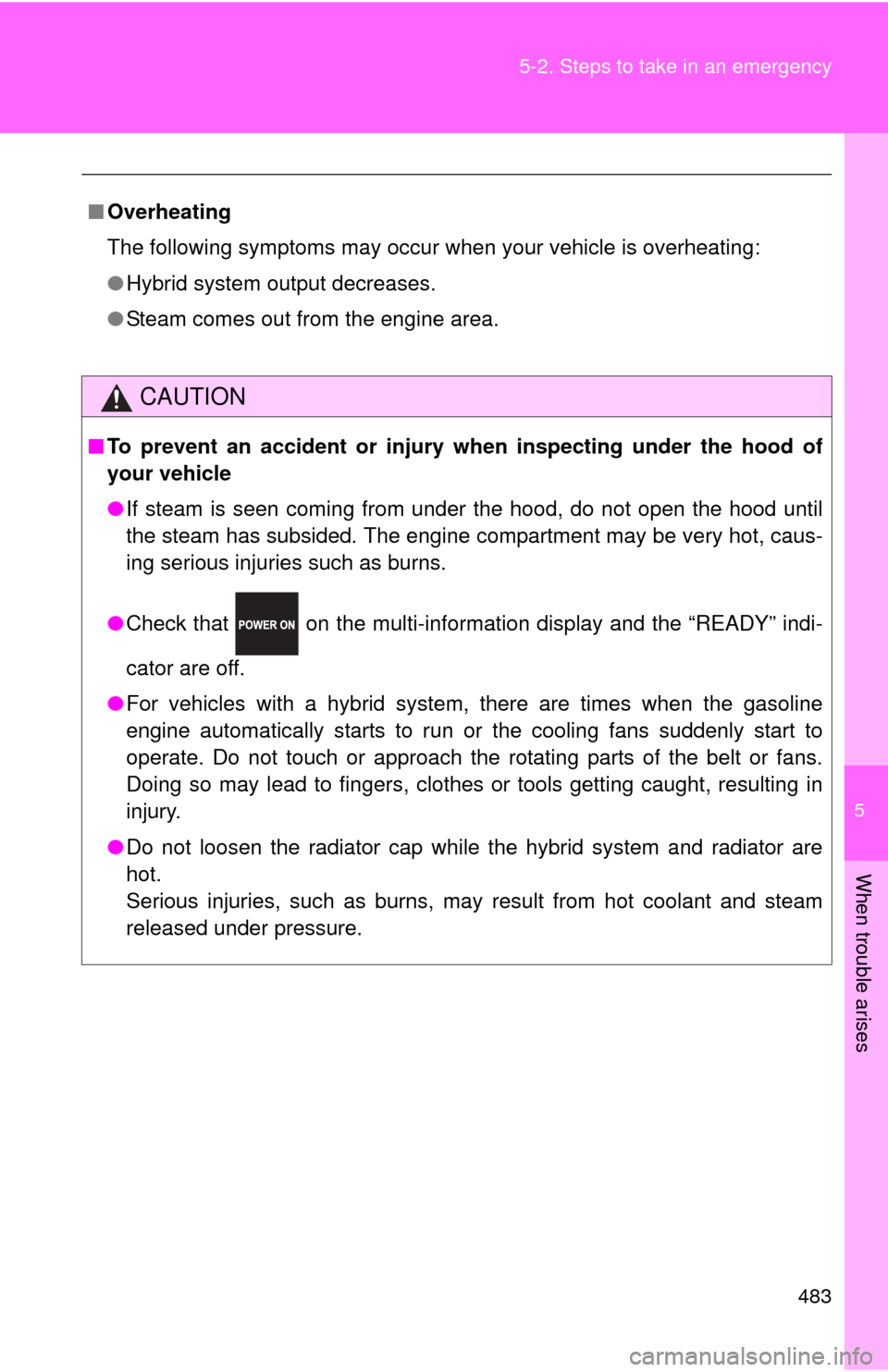
5
When trouble arises
483
5-2. Steps to take in an emergency
■
Overheating
The following symptoms may occur when your vehicle is overheating:
●Hybrid system output decreases.
● Steam comes out from the engine area.
CAUTION
■To prevent an accident or injury when inspecting under the hood of
your vehicle
●If steam is seen coming from under the hood, do not open the hood until
the steam has subsided. The engine compartment may be very hot, caus-
ing serious injuries such as burns.
● Check that on the multi-information display and the “READY” indi-
cator are off.
● For vehicles with a hybrid system, there are times when the gasoline
engine automatically starts to run or the cooling fans suddenly start to
operate. Do not touch or approach the rotating parts of the belt or fans.
Doing so may lead to fingers, clothes or tools getting caught, resulting\
in
injury.
● Do not loosen the radiator cap while the hybrid system and radiator are
hot.
Serious injuries, such as burns, may result from hot coolant and steam
released under pressure.
Page 493 of 552
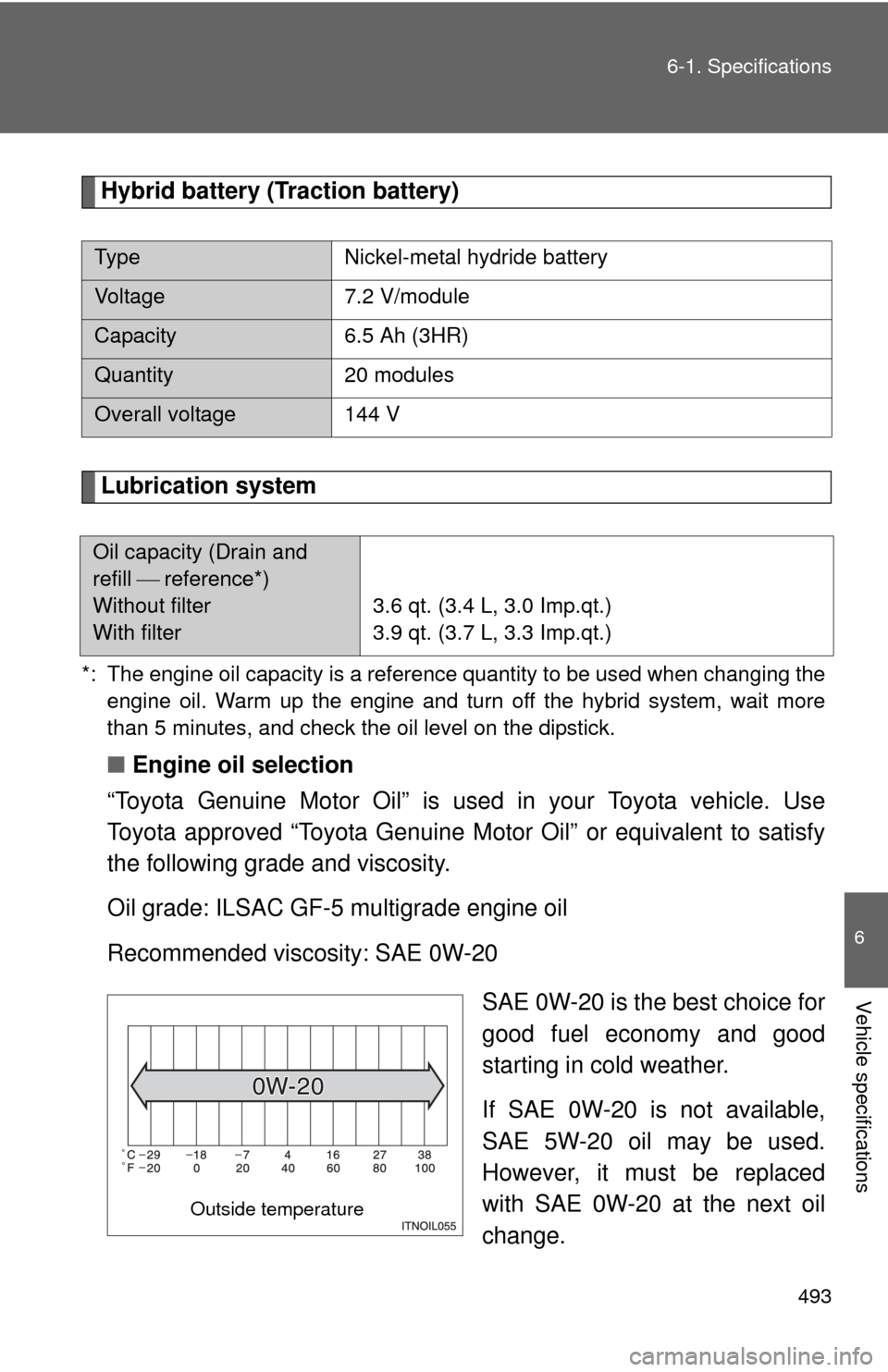
493
6-1. Specifications
6
Vehicle specifications
Hybrid battery (Traction battery)
Lubrication system
*: The engine oil capacity is a reference quantity to be used when changing the
engine oil. Warm up the engine and turn off the hybrid system, wait more
than 5 minutes, and check the oil level on the dipstick.
■Engine oil selection
“Toyota Genuine Motor Oil” is used in your Toyota vehicle. Use
Toyota approved “Toyota Genuine Motor Oil” or equivalent to satisfy
the following grade and viscosity.
Oil grade: ILSAC GF-5 multigrade engine oil
Recommended viscosity: SAE 0W-20
SAE 0W-20 is the best choice for
good fuel economy and good
starting in cold weather.
If SAE 0W-20 is not available,
SAE 5W-20 oil may be used.
However, it must be replaced
with SAE 0W-20 at the next oil
change.
TypeNickel-metal hydride battery
Voltage7.2 V/module
Capacity6.5 Ah (3HR)
Quantity 20 modules
Overall voltage 144 V
Oil capacity (Drain and
refill reference*)
Without filter
With filter 3.6 qt. (3.4 L, 3.0 Imp.qt.)
3.9 qt. (3.7 L, 3.3 Imp.qt.)
Outside temperature